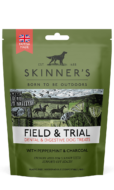Understanding the vitamins that go into your dog’s food
Written by Zoe Russell, BSc (Hons)

Nutrition Officer, Skinner’s
With so many different foods out there, it can be difficult to know what is best for your dog. The back of the bag can often be a good place to start; but what does all the information on the back mean? In particular, why do we see vitamins on the label?
What are vitamins?
Vitamins are organic compounds required by living organisms in quite small amounts to maintain normal health. They are often referred to as either fat-soluble or water-soluble and have different functions within the body. Animals are unable to make some vitamins themselves and so must have sufficient amounts in their diet. This is why Skinner’s wet and dry diets are all balanced and complete, to ensure dogs get the right nutrients they need to stay healthy.
Why are vitamins declared on a dog food label?
When vitamins A and D3 are added to a product, the levels must be declared on the packaging because they have maximum levels for some species. You may notice them labelled under the heading “additives”. By adding these vitamins, this ensures our diets can remain nutritionally balanced and complete, meaning you don’t have to add anything else to their food for them to get the nutrients they need. For more information, please take a look at the PFMA labelling fact sheet at https://www.ukpetfood.org/resource/labelling-factsheet.html.
What vitamins are there and what do they do?
Vitamin A
Supports normal vision, a healthy coat and skin as well as healthy teeth.
Vitamin B Complex
Supports metabolic processes. These vitamins help with a whole range of processes within the body to ensure it functions as normal.
Vitamin C
Supports immune function.
Vitamin D
Supports calcium and phosphorus balance within the body, which are good for building healthy bones.
Vitamin E
Has antioxidant properties, which support a dog’s defences against oxidative damage in the body.
Vitamin K
Involved in blood clotting.
Other information on the label
Pet food manufacturers must declare the level of protein, fat, fibre and ash of a food on the label. If the moisture level exceeds 14% then they must also declare the moisture of the food, hence why you often see this on wet food packaging.
You will often see “trace elements” listed at the bottom of a bag, or in their product leaflet. These are listed because they have an upper, legal limit so must be declared on-pack. These have useful purposes within the body and help keep a dog healthy and happy when part of a balanced and complete diet.
Key words you will see on the label
Complete dog food
This describes a food that is nutritionally complete and provides all the nutrients in the right amounts needed for your dog to stay healthy. These foods can be fed daily without the need to add other food products.
Complementary
These foods should only form part of a dog’s diet as they do not meet their daily nutritional requirements when fed alone. They should be fed in moderation, alongside a complete diet, and should not take up more than 10% of your dog’s daily intake. For example, Field and Trial Digestive & Dental treats.

Dental & Digestive Treats
Formulated with a slight crunch to aid in teeth cleaning.
£2.30 – £17.99
Contact us
If you need any more information about our diets, then please contact our nutrition team at nutritionsupport@skinners.co.uk or call us on 01379 384247.



